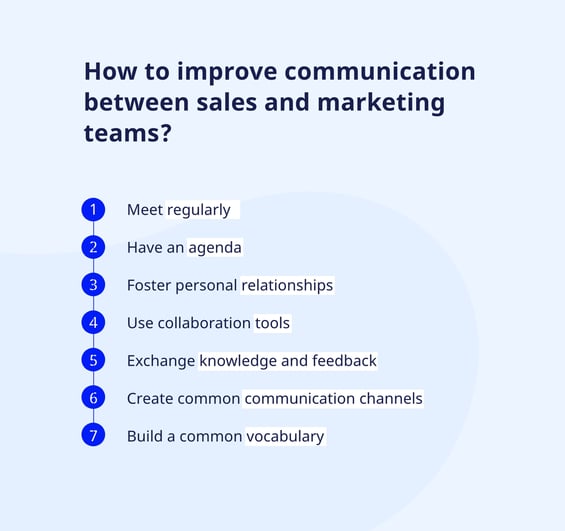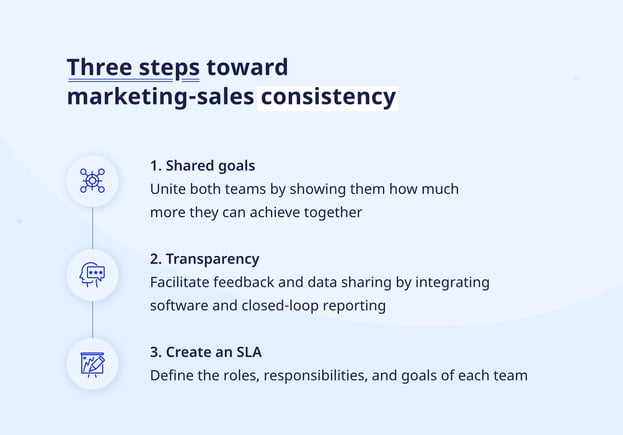On paper, the cooperation between marketing and sales feels like a perfect symbiosis: the former generates leads that the latter can convert into customers. But, in the end, everyone’s the winner.
In reality, things aren’t that simple. For example, 9 in 10 professionals admit that the sales and marketing departments are misaligned regarding content, strategy, and processes. Unfortunately, this means that most organizations don’t use marketing and sales to their full potential and, as a result, don’t make as much profit as possible. In fact, 43% of CEOs believe the lack of marketing and sales alignment costs them sales.
43% of B2B executives believe that marketing and sales misalignment causes their companies to lose money.
[Source: Forrester]
So, what causes these disruptions, and how can you replace them with sales and marketing alignment? The answer lies in three words that all conveniently—but not coincidentally—start with the same letter…
What’s sales and marketing alignment?
Teamwork makes dream work—that saying may be a little timeworn, but it perfectly captures the essence of sales-marketing alignment.
Also known as smarketing, marketing and sales alignment refers to integration and collaboration between two departments through shared goals, processes, and communication. Put shortly, smarketing allows your organization to capitalize on more opportunities, ultimately leading to better business outcomes.

All these benefits aside, avoiding sales and marketing misalignment is another strong reason to adopt smarketing good practices. The lack of sync between the two teams can have many negative consequences, such as:
- Inconsistent goals and vision,
- Struggle to find qualified leads,
- Tension (or even hostility) between departments,
- No cross-department transparency,
- Inability to convert enough leads,
- Poor customer understanding,
- Lower-than-expected ROI.
To prevent that, let’s examine what causes misalignment and how marketing and sales work together by dissecting the three key components of a successful smarketing integration.
Communication
The first step toward sales and marketing alignment is ensuring the two teams exchange information frequently and efficiently. This seems like a no-brainer, but let’s be honest: how often do your marketers and salespeople talk to each other?
If your answer is something like, “Well, I’ve seen them greet by the coffee machine…,” there’s a good chance that there’s some room for improvement. Here’s what you can do.
Hold regular meetings
Routine meetings are essential to keep all stakeholders equally involved and informed. They allow your sales and marketing teams to review ongoing and past campaigns, share insights, set goals, and update others on the progress.
One way to approach it is by holding weekly status meetings for team representatives and monthly meetings for all members of both teams where you discuss major topics like funnel integration or sales insights for your marketing strategy. This will allow you to keep everyone in the know without wasting their precious time.

Create and nurture relationships
The quality of communication is even more crucial than its regularity. To make recurring meetings worthwhile, plan each (what’s the goal, what you want to get out of it) and stick to the agenda.
However, you also want to ensure no animosity between teams. That’s why it’s particularly important to maintain a good relationship between their leaders—alignment starts at the top, so their interactions will determine the outcome of all your smarketing initiatives.
Work events provide an additional opportunity to create a more casual bond between your sales and marketing pros. Over time, you may observe an unexpected—but very much welcome—side effect of your alignment efforts: no more awkward moments during company get-togethers!
Establish common communication channels
The flow of information must continue outside the meetings. For that, your sales and marketing experts need a convenient communication method.
Start by creating a common email address (like “smarketing@yourbiz.com”) specifically for your smarketing efforts. Another good idea is to set up a dedicated workspace on the platform your organization already uses, such as Slack, Microsoft Teams, or Discord. Then, combine it with collaboration tools like shared project management boards, documents, calendars, or cloud storage, and voila—you’ve just brought your sales and marketing teams one step closer together.
Share knowledge
No matter how tightly integrated sales and marketing teams are, they will always have specific tasks and areas of expertise. However, sharing some of that knowledge between departments will lead to better mutual understanding, closer collaboration, or even new perspectives and insights.
For instance, marketers can run product training sessions and workshops to help salespeople learn more about your offering. Conversely, sales call shadowing, and recordings will give your marketing team access to firsthand personal feedback directly from customers.
Make sure they speak the same language
The last thing is to make everyone familiar with both teams' essential terminology. This includes agreeing on the meaning of common concepts to ensure everyone’s on the same page.
For example, you should specify what exactly “sales-ready lead” or “ideal customer profile” refers to, as sales and marketing teams can understand these terms differently.

Consistency
Ideally, you’d like your marketing and sales pipelines to connect seamlessly. But unfortunately, the smooth transfer of information is often interrupted by incongruous workflows, KPIs, or vision, resulting in more leaks than leads. Smarketing offers several solutions to reduce that friction.
Set common goals and milestones
Coordinating the work of two departments gets much easier when they both collaborate toward the same goal. A common objective will strengthen the relationship between sales and marketing teams while meeting major milestones along the way will give everyone involved a motivating sense of accomplishment.
Follow the SMART (Specific, Measurable, Achievable, Relevant, and Timely) rule to avoid vague and trivial objectives such as “I want my marketing and sales team to become more aligned.” Instead, aim for well-defined goals like “I want my sales and marketing teams to grow company revenue by 5% through communication and shared funnel by the end of this year.”
Implement closed-loop reporting and data transparency
Tracking your progress toward the shared goals can be tricky since both departments use different tools and datasets. By granting salespeople access to the marketing data (and vice versa), you can evaluate your KPIs and processes from the shared perspective to develop improvements. A great first step is integrating all your data within one system like HubSpot Sales and Marketing.
Establishing closed-loop reporting will help you achieve data visibility. Ask your salespeople to give marketers follow-up feedback about the leads they delivered. Once you “close the loop,” sales and marketing teams will get the data needed to improve the process. The marketing team can use these findings to identify the best lead sources.
Create a Service Level Agreement (SLA)
Think of an SLA as an agreement between your sales and marketing teams. It’s a document that lists the roles of each department in the lead generation process, as well as their respective services, responsibilities, and goals. For example, marketing has to deliver X quality leads per month, and sales will reach out to Y of these leads over a set period.
This may seem strict, but a thoroughly planned SLA can be a cornerstone of sales and marketing alignment. SLA creates accountability by clearly defining expectations and preventing task overlap between departments. And with measurable goals to meet, you also ensure that no decisions will be made based on emotions. At last, Marketing Mark will have no choice but to admit that Sales Suzie is doing a fantastic job—they may even become friends!

Collaboration
The final disruptive factor is as banal as it is fundamental: despite being so interdependent, sales and marketing only sometimes get to cooperate.
However, now that your communication lines are set up, and inconsistencies are out, your marketing and sales teams can finally start working together for the common good of the entire company. Here are some areas where sales and marketing alignment will have the most impact.
- Shared content creation — Marketing teams focus on the product, while sales are often more concerned with clients and their needs. Combining these two approaches will allow you to create content and messaging that’s both product-led and holds real value for your customers.
- Building buyer personas — Since their workflows are so different, it’s sometimes easy to forget that sales and marketing target the same customer. However, when they join forces to build and constantly update your ideal customer profile, the result is spot-on buyer personas that perfectly capture the characteristics of your audience.
- Improving customer experience — Sales and marketing alignment helps break data silos and give both teams a broader view of their clients. Then, they can use that data to deliver an excellent customer experience, increasing conversion and retention rates.
- Managing lead handoffs — Most of the friction between marketing and sales occurs during lead handoffs. Better mutual understanding and closer communication will allow the two teams to bridge the gap by accurately defining your SQL and then planning further improvements, such as lead scoring automation.
- Gaining a competitive edge — An important part of a marketer’s job is to follow industry trends, monitor your competitors' activity, and see how you fare against them. Salespeople can tap into that knowledge to communicate your advantages to prospects and convince them that it’s your products or services that they should choose.
Better together with marketing and sales alignment
From increased ROI to coherent vision, there are many reasons why you should bring your sales and marketing together. But first and foremost, smarketing lets you turn two crucial departments of your organization into a true, tightly-knit team.
The road to full alignment won’t be easy, but we’re here to help. So whether it’s a marketing strategy, sales empowerment, or HubSpot implementation, look no further: get in touch and let us know what you need!



 September 2023
September 2023
